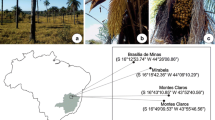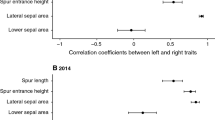Abstract
Fourteen common southern Spanish species in theCistaceae were examined for quantitative variations in floral traits. These included the diameter of the corolla, number and size of anthers, number of ovules, and the size and shape of the gynoecium. The variables were in most instances positively correlated, species with larger flowers having more and larger anthers, more ovules, etc. Shrubs were observed to possess the largest, annuals the smallest, and subshrubs medium-sized flowers. Detailed observations of flower structure and function in a shrub (Cistus salvifolius), a spring-annual (Tuberaria guttata) and a winter-annual (T. inconspicua), revealed substantial variations in the breeding system. WhileC. salvifolius (and probably most woody species in this family) presents self-incompatibility, annual species ofTuberaria are self-compatible. In the studied population,T. inconspicua plants bore only reduced, cleistogamous flowers with no sign of a corolla.T. guttata has chasmogamous flowers that can facultatively self-pollinate.
Similar content being viewed by others
References
Agami, M., 1987: The establishment, growth, phenology, and longevity of two species ofHelianthemum in the Negev Desert Highlands, Israel. — Oecologia71: 486–490.
Arroyo, J., 1990: Geographic variation of flowering phenology in twenty-six common shrubs in SW Spain. — Flora184: 43–49.
—,Herrera, J., 1988: Polinizacion y arquitectura floral enEricaceae de Andalucía Occidental. — Lagascalia15: 615–623.
Berliner, R., Benjamin, Z., Zamski, E., 1986: Absence ofCistus incanus from basaltic soils in Israel: effect of mycorrhizae. — Ecology67: 1283–1288.
Brandt, U., Gottsberger, G., 1988: Flower phenology, pollinating insects and breeding systems inCistus, Halimium andTuberaria species in Portugal. — Lagascalia15: 625–634.
Corral, R., Pita, J. M., Perez-Garcia, F., 1990: Some aspects of seed germination in four species ofCistus L. — Seed Sci. Technol.18: 321–325.
Cruden, R. W., 1977: Pollen-ovule ratios: a conservative indicator of breeding systems in flowering plants. — Evolution31: 32–46.
Dansereau, P., 1941: Etudes sur les hybrides de Cistes. IV. Correlation des characteres duC. salvifolius L. — Canad. J. Research19: 27–39.
—, 1943: Etudes sur les hybrides de Cistes. V. Le comportement du ×Cistus florentinus Lam. — Candollea10: 9–22.
Darwin, C., 1877: The different forms of flowers on plants of the same species. — London: Murray.
Faegri, K., van der Pijl, L., 1979: Principles of pollination ecology. 3rd edn. — Oxford: Pergamon Press.
Farmer, A. H., 1984: Competition and spacing in the shrubHalimium halimifolium (L.)Willk. from a semi-arid region of southern Spain. — Oecologia Generalis5: 169–174.
Fryxell, P. A., 1957: Mode of reproduction of higher plants. — Bot. Rev.23: 135–233.
Gallego, M. J., 1991: Notas sobre las especies anuales del géneroTuberaria (Dunal)Spach. — Lagascalia16: 106–112.
Guinea, E., 1954: Cistaceas españolas. — Madrid: Instituto Forestal de Investigaciones y Experiencias.
Herrera, J., 1985: Nectar secretion patterns in southern Spanish Mediterranean scrublands. — Israel J. Bot.34: 47–58.
—, 1986: Flowering and fruiting phenology in the coastal shrublands of Doñana, south Spain. — Vegetatio68: 91–98.
—, 1987a: Flower and fruit biology in southern Spanish Mediterranean shrublands. — Ann. Missouri Bot. Gard.74: 69–78.
—, 1987b: Biologia reproductiva de algunas especies del matorral de Doñana. — Anal. Jard. Bot. Madrid44: 483–497.
—, 1988: Pollination relationships in southern Spanish Mediterranean shrublands. — J. Ecol.76: 274–287.
- 1992: Reproductive characteristics of a stable-dune therophyte community in Doñana (S. Spain). — Israel J. Bot. (in press).
Heywood, V. H., 1968:Cistaceae. — InTutin, T. G., & al. (Eds.): Flora Europaea2, pp. 282–292. — Cambridge: Cambridge University Press.
—, 1978: Flowering plants of the world. — Oxford: Oxford University Press.
Jain, S. K., 1976: The evolution of inbreeding in plants. — Ann. Rev. Ecol. Syst.7: 469–495.
Lord, E. M., 1981: Cleistogamy: a tool for the study of floral morphogenesis, function, and evolution. — Bot. Rev.47: 421–450.
Martin-Bolaños, M., Guinea, E., 1949: Jarales y jaras. — Madrid: Instituto Forestal de Investigaciones y Experiencias.
Martin, F. W., 1959: Staining and observing pollen tubes in the style by means of fluorescence. — Stain Technol.34: 125–128.
Ornduff, R., 1969: Reproductive biology in relation to systematics. — Taxon18: 121–133.
Preston, R. E., 1986: Pollen-ovule ratios in theCruciferae. — Amer. J. Bot.73: 1732–1740.
Quezel, P., 1981: Floristic composition and phytosociological structure of sclerophyllous matorral around the Mediterranean. — Indi Castri, F., Goodall, G. W., Specht, R. L. (Eds.): Mediterranean type ecosystems, pp. 107–121. — Amsterdam: Elsevier.
Rivas-Martinez, S., 1979: Brezales y jarales de Europa occidental. — Lazaroa1: 5–128.
Schemske, D. W., 1978: Evolution of reproductive characteristics inImpatiens (Balsaminaceae): the significance of cleistogamy and chasmogamy. — Ecology59: 596–613.
Sokal, R. R., Rohlf, F. J., 1981: Biometry. 2nd edn. — San Francisco: Freeman.
Stebbins, G. L., 1957: Self fertilization and population variability in the higher plants. — Amer. Naturalist91: 337–354.
Trabaud, L., Oustric, J., 1989: Heat requirements for seed germination of 3Cistus species in the garrigue of southern France. — Flora183: 321–326.
Trapp, E. J., Hendrix, S. D., 1988: Consequences of a mixed reproductive system in the Hog Peanut,Amphicarpea bracteata. — Oecologia75: 285–290.
Troumbis, A., Trabaud, L., 1986: Comparison of reproductive biological attributes of twoCistus species. — Acta Oecol., Oecol. Plant.7: 235–250.
Wiens, D., 1984: Ovule survivorship, brood size, life history, breeding systems, and reproductive success in plants. — Oecologia64: 47–53.
Wyatt, R., 1988: Phylogenetic aspects of the evolution of self-pollination. — InGottlieb, L. D., Jain, S. K., (Eds.): Plant evolutionary biology, pp. 109–131. — London: Chapman & Hall.
Author information
Authors and Affiliations
Rights and permissions
About this article
Cite this article
Herrera, J. Flower variation and breeding systems in theCistaceae . Pl Syst Evol 179, 245–256 (1992). https://doi.org/10.1007/BF00937600
Received:
Revised:
Accepted:
Issue Date:
DOI: https://doi.org/10.1007/BF00937600




